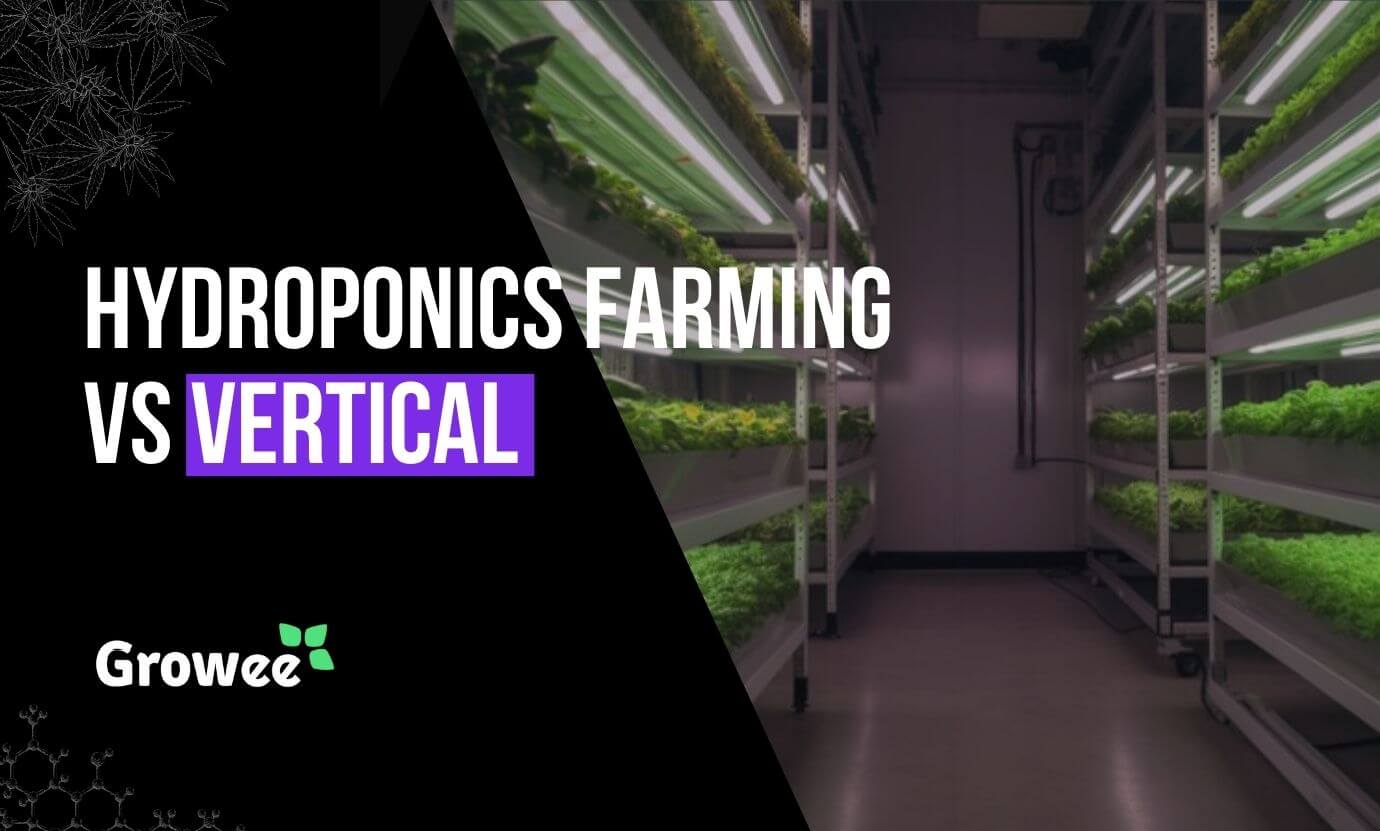The growing demand for fresh produce in our fast-paced world has led to the emergence of innovative farming methods like hydroponic and vertical farming. These modern techniques each have their unique advantages, but they also come with certain challenges. In this blog, we’ll dive into the fascinating world of hydroponic and vertical farming, examining their benefits, drawbacks, and contributions to sustainable agriculture.
What is Hydroponic Farming?
Hydroponic farming is an intriguing alternative to traditional soil-based agriculture. It involves nurturing plants in nutrient-rich water solutions instead of soil, providing them with all the essential nutrients they need to grow. As a result, plants flourish more quickly and efficiently. This soil-less approach to farming can be employed to grow a diverse array of crops, from vibrant leafy greens to delectable fruit-bearing plants.
What is Vertical Farming?
On the other hand, vertical farming takes a different approach to maximize space and efficiency. It involves the cultivation of plants in vertically stacked layers or inclined surfaces, usually within controlled environments like greenhouses or warehouses. Vertical farming is especially beneficial in crowded urban areas where space is at a premium, as it optimizes the use of limited space. A variety of techniques can be incorporated into vertical farming, including hydroponics, aeroponics, and aquaponics, further enhancing its versatility.
See How Growee Can Save You Time By Automating Your Plants Feeding
Water pH – Automated pH Up and Down Control
Nutrients Mixing – Automated Nutrient Dosing with Target EC / PPM Control.
Control From Anywhere – WiFi Connection and mobile App
Benefits and Drawbacks of Hydroponic Farming
Hydroponic farming offers several remarkable advantages, but it also comes with its fair share of challenges. Here are three key benefits and drawbacks of this innovative farming method:
Benefits:
- Water efficiency: Hydroponic systems conserve water, using up to 90% less than traditional soil-based farming. This is possible because water can be recirculated, minimizing waste.
- Faster growth: Hydroponically grown plants often develop more quickly, thanks to direct access to nutrients and ideal growing conditions.
- Pest control: Without soil, hydroponic systems eliminate the risk of soil-borne pests and diseases, promoting healthier plant growth.
Drawbacks:
- Start-up costs: Setting up a hydroponic system can be costly, particularly for large-scale operations.
- Technical expertise: To succeed in hydroponic farming, you’ll need a strong understanding of plant nutrition, system maintenance, and environmental control.
- Equipment maintenance: Hydroponic systems require ongoing attention and care, as components like pumps and nutrient delivery systems need regular maintenance, which can be time-consuming.
Benefits and Drawbacks of Vertical Farming
Vertical farming presents a range of benefits and challenges that make it a compelling option for urban agriculture. Here are three key advantages and drawbacks of this cutting-edge farming method:
Benefits:
- Space efficiency: Vertical farming optimizes space usage by accommodating a higher density of plants within a limited area, making it perfect for space-constrained urban environments.
- Year-round growing: The controlled conditions in vertical farms enable crops to grow throughout the year, facilitating multiple harvests annually.
- Reduced transportation costs: By cultivating produce locally in urban areas, vertical farming decreases the need for transportation, lowering costs and minimizing the carbon footprint.
Drawbacks:
- High start-up costs: Establishing a vertical farm can be costly, especially when integrating advanced technologies such as climate control and automation.
- Energy consumption: Vertical farming often necessitates artificial lighting, climate control, and other energy-demanding systems, resulting in increased energy expenses.
- Plant selection: Vertical farming isn’t suitable for all plants, making crop selection a critical factor in determining success.
Can Hydroponics be used in Vertical Farming?
Hydroponics and vertical farming can be combined to create even more efficient and productive systems. Let’s take a closer look at how hydroponics is being used in vertical farming to grow a variety of crops.
One example is the use of hydroponics in cannabis cultivation. Many cannabis growers are turning to hydroponic vertical farming to grow seedlings under LED lights. By stacking several levels of plants, each with their own LED light, space is maximized, and the growing environment is fully controlled, leading to the production of high-quality cannabis plants
Hydroponic vertical farming has also proven successful in urban farming for leafy greens. In controlled environments, crops such as lettuce, kale, and spinach can be grown year-round, providing fresh produce for city dwellers. The efficient use of space and resources makes hydroponic vertical farming an attractive option for producing food in urban areas.

Hydroponic and Vertical Farming Methods Play a Significant Role in Promoting Sustainability
- While these innovative farming techniques may result in higher electricity costs, the advantages of local production far outweigh this drawback. Growing food locally reduces the carbon footprint associated with transportation, storage, and pollution.
- Moreover, hydroponic and vertical farming methods consume fewer resources and decrease the need for chemical pesticides, making them a more environmentally friendly option compared to traditional soil-based agriculture. These systems also exhibit greater resilience against the impacts of climate change, which can have devastating effects on conventional farming.
- By cultivating food in close proximity to where it is consumed, hydroponic and vertical farming help to minimize the environmental impact associated with food transportation, storage, and waste management. In doing so, these cutting-edge farming techniques have the potential to transform food production, making it more sustainable and accessible for all.
Growee Revolutionizing Urban Farming with Tailored Solutions for Small-Scale Vertical Farming Systems
In the world of urban farming, Growee is making a significant impact by offering tailored feeding control solutions specifically designed for small-scale vertical farming systems. The platform provides an easy-to-use interface for monitoring and controlling plant feeding and environmental conditions, simplifying the management of hydroponic and vertical farming setups.
By catering to the unique needs of urban farmers, Growee promotes sustainable agriculture practices in limited spaces, making it accessible to a wider audience. The platform’s advanced technology enables users to optimize their vertical farming systems, ensuring that crops receive the right nutrients and environmental conditions to thrive. This level of control and customization is crucial in urban settings, where space and resources are often limited.
Growee’s innovative approach to urban farming has the potential to encourage more people to embrace sustainable agricultural practices within their communities. By providing a tailored solution built specifically for small-scale vertical farming, Growee is revolutionizing the way we approach food production in urban environments, making it more sustainable, efficient, and accessible for everyone.
Conclusion
Hydroponic and vertical farming are innovative methods that address the challenges of urban agriculture, offering numerous benefits such as efficiency and sustainability. Platforms like Growee make these techniques more accessible, promoting their widespread adoption in urban environments. As we face a growing global population and increasing urbanization, embracing advanced farming techniques is vital for ensuring sustainable and efficient food production for all.
FAQ
What is the main difference between hydroponic farming and vertical farming in urban agriculture?
Hydroponic farming uses nutrient-rich water solutions, while vertical farming focuses on growing plants in stacked layers or inclined surfaces. Both can be used in urban settings.
Which urban farming method is more efficient in terms of water usage: hydroponic or vertical farming?
Hydroponic farming is more water-efficient as it recirculates water, using up to 90% less than traditional methods. Vertical farming can also be water-efficient when combined with hydroponics.
Which method is more cost-effective for urban farming: hydroponic farming or vertical farming?
Cost-effectiveness depends on factors like scale, crop type, and location. Initial costs can be high for both methods, but operational costs may vary depending on system design and efficiency.
Can hydroponic systems be combined with vertical farming for increased efficiency?
Yes, combining hydroponics with vertical farming allows for greater space and resource efficiency, enhancing productivity in urban farming.
What are the environmental benefits of hydroponic farming and vertical farming in urban settings?
Both methods reduce water and land use, decrease the need for pesticides, and minimize transportation-related emissions by producing food locally.
Are there any regulatory considerations for hydroponic or vertical farming operations in urban agriculture?
Regulations may vary by location. It’s essential to research local laws regarding zoning, land use, and agricultural practices before starting an urban farming operation.
Which crops are best suited for hydroponic farming vs. vertical farming in urban environments?
Hydroponic farming is ideal for crops like lettuce, tomatoes, and herbs. Vertical farming is suitable for leafy greens and small fruiting plants, especially when combined with hydroponics.
How does Growee improve urban hydroponic and vertical farming efficiency?
Growee offers tailored solutions for small-scale systems, simplifying plant feeding and environmental monitoring, and promoting sustainable urban farming practices.



